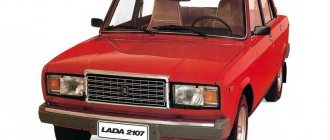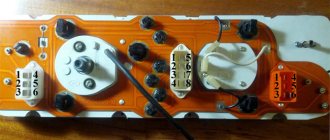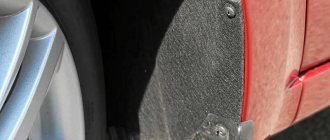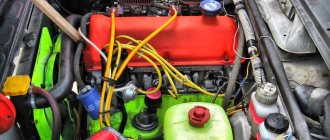Main characteristics of the model
In the large model range of Zhiguli cars, the VAZ-21074 stands apart. A powerful engine with a displacement of 1569 cm 3 gave it the right at that time to be considered the fastest rear-wheel drive sedan that rolled off the assembly line of the Volzhsky Automobile Plant.
On the first models of the 7th series, the engine was similar to the 5th model. Only a little later they began to install a more powerful engine from the no less popular VAZ-2106 car.
The vehicle's ground clearance is 17.5 cm. The installed tires have an outer radius of 165 mm. The volume of the luggage compartment is 355 liters. The total curb weight of the vehicle is 1430 kg. Maximum speed is 150 km/h. In 16 seconds the car accelerates to hundreds. A fuel tank of 39 liters allows you to store a fuel reserve of 400 km in urban mode.
The brake system did not change and was inherited from the prototype model - VAZ 2105. Initially, these cars were almost identical, but, nevertheless, they had certain distinctive features, namely:
- shape of the hood and trunk;
- radiator screen;
- rear lights;
- chrome bumper trims.
The car has proven itself to be unpretentious in operation, and the cost of spare parts is in an affordable price segment. This aspect is one of the main factors that positively influences the buyer’s choice (in favor of the VAZ-21074). We will consider the technical characteristics of components and assemblies in more detail below.
How much does the VAZ weigh?
Perhaps one of the most popular cars in the post-Soviet space was, is and remains the VAZ. This car has captivated many generations. However, how did it all begin? When was the first VAZ car produced and how much did it weigh? You will learn the answers to these and other questions from this article. The first VAZ car was produced by the Volzhsky Automobile Plant on April 19, 1970. The make of this car was VAZ-2101 “Zhiguli”. Its production was carried out according to the analogue of the Fiat concern. Moreover, the VAZ owes its appearance to this particular brand of the Fiat 124 car produced in 1966. Here, in fact, is it: As a result of some design improvements, the first domestic car, the VAZ 2101 of 1970, was produced:
The weight of this car was 955 kg. Moreover, of this mass the engine weighed 114 kg.
It has not lost its popularity to this day. In 2000, it was recognized as the best car among eighty thousand car enthusiasts surveyed in the CIS countries and Russia. It was named the best car of the century, VAZ 2101. At the time of its production, it was considered the most comfortable, reliable and modern domestic car. Its presence was a sign of wealth and prosperity!
But the Volzhsky Automobile Plant did not stop there. He created entire collections of this car. Each of them differed in its configuration, as well as its total weight. Therefore, now we will compare some VAZ models by their weight.
- VAZ 2102 has a weight of 1010 kg.
- VAZ 2103 weighs 965 kg.
- VAZ 2104 has a weight of 1020 kg.
- VAZ 2105 has a weight of 1060 kg.
- VAZ 2106 weighs 1045 kg.
- VAZ 2107 weighs 1049 kg.
- VAZ 2108 weighs 945 kg.
- VAZ 2109 weighs 915 kg.
- VAZ 2110 has a weight of 1020 kg.
- VAZ 2111 weighs 1055 kg.
- VAZ 2112 has a weight of 1060 kg.
- VAZ 2113 weighs 975 kg.
- VAZ 2114 weighs 985 kg.
- VAZ 2115 weighs 1000 kg.
- VAZ 2116 weighs 1276 kg.
- VAZ 2117 weighs 1110 kg.
- VAZ 2118 has a weight of 1110 kg.
- VAZ 2119 has a weight of 1110 kg.
- VAZ 2120 has a weight of 1110 kg.
- VAZ 2121 has a weight of 1550 kg.
- VAZ 2122 has a weight of 1122 kg.
- VAZ 2123 has a weight of 1300 kg.
But this is the total weight of a VAZ car. As for some parts of the car, the weight of, for example, a VAZ 2106 can be decomposed as follows:
- The weight of the engine with equipment is 140 kilograms.
- The weight of the gearbox is 26 kilograms.
- The weight of the square shaft is 10 kilograms.
- The weight of the rear axle is 52 kilograms.
- The weight of the radiator is 7 kilograms.
- Body weight – 280 kilograms.
On average, the weight of all components of a VAZ car has approximately the same mass. Throughout the entire period of existence of this car, quite interesting facts have been recorded that simply cannot be ignored. It’s hard to imagine that a car weighing an average of 1 ton is very popular.
So, the VAZ 2121 Niva car is not only the most popular throughout the USSR, but also the most exported. Just imagine, this model was produced in 1.8 million cars. And of this amount, 500,000 were sold to more than 100 countries. As we remember, the weight of the VAZ 2121 is 1550 kilograms. This means that over the entire period, 775,000,000 kilograms of this car were sold! Also, this particular model of all Soviet cars was driven in Japan. As for the design of the VAZ 2108, it was developed by the currently well-known company Porshe. The weight of its engine is 127.3 kilograms. This became necessary due to the fact that the demand for this brand of car was greatly reduced. For this reason, they decided to modernize it.
Moreover, the VAZ car became more popular because the Lada car was the first car of the famous Formula 1 racer - Kimi Raikkonen. His father loved this car extremely much for its reliability.
So, we learned that each VAZ car model has its own separate weight. But throughout the history of its existence and production, it has not undergone major changes.
Salon VAZ-21074
The design of all modifications of the VAZ-2107 family (including the VAZ-21074 injector) provides for the arrangement of components and assemblies according to the so-called classical scheme, when the rear wheels are driven and the engine is shifted forward as much as possible, thereby ensuring optimal weight distribution along the axles and, as a result, improving vehicle stability. Thanks to this arrangement of the power unit, the interior turned out to be quite spacious and was located inside the wheelbase, i.e., in the zone of best ride smoothness, which could not but affect the comfort of the car.
The interior of the VAZ-21074 turned out to be quite spacious and comfortable
The interior trim is made of high-quality non-glare materials. The floor is covered with mats made of non-woven material on a polypropylene base. The body pillars and doors are upholstered in semi-rigid plastic, covered on the front side with caprovelor; velutin is used for seat upholstery. The ceiling is finished with polyvinyl chloride film with a duplicated foam pad, glued to a base formed from plastic. Through the use of various mastics, layered bitumen gaskets and felt inserts:
- heat and sound insulation of the interior is achieved;
- vibration is eliminated;
- Metal components are protected from corrosion.
Engine and transmission
The engine from the VAZ-2106 was installed on the VAZ-21074 model without any modifications. The technical characteristics of the engine made it possible to achieve a power of 74 hp. With. There are 2 valves per cylinder. The “five” had a belt drive of the camshaft, which made the engine less noisy. However, a belt is less reliable than a chain. Therefore, on a more powerful engine, it was decided to leave the timing chain transmission unchanged.
The gearbox compares favorably with its predecessors. It has a fifth speed, the gear ratio of which is 0.819. All other speeds have lower gear ratios compared to previous analogues. As a result, the gearbox operates more “softly”. The rear axle gearbox with self-locking differentials has 22 splines - it was borrowed from the VAZ-2106 model.
The suspension of the front pair of wheels is independent. The rear suspension has a rigid beam. This design significantly improved the car's stability when cornering.
Transmission
| Clutch | single-disk, dry, with hydraulic shutdown drive and central diaphragm spring | |||
| Transmission | mechanical, four- or five-speed, three-way, three-shaft, with synchronizers on all forward gears | |||
| Gear ratios: | ||||
| first | 3,67 | |||
| second | 2,10 | |||
| third | 1,36 | |||
| fourth | 1,0 | |||
| fifth | 0,82 | |||
| reverse | 3,53 | |||
| Cardan transmission | two-shaft, with intermediate support and elastic coupling | |||
| main gear | hypoid | |||
| Final drive ratio | gear ratio - 3.9 or 4.1 | |||
| Differential | conical, two-satellite | |||
Design and construction
Compared to the basic “five”, the luxury version of the VAZ-2107 received a new and even daring front design, a different radiator grille, which was most often chrome-plated, plastic bumpers with chrome trims. To accommodate the new radiator grille with a larger area, the shape of the hood had to be changed. Less noticeable changes include slightly modified rear lights and a modified shape of the trunk lid; compared to the VAZ-2105, there were no stampings on it, but since 2008, due to unification, the shape of the lid has become the same as that of the “five”.
In the interior of the VAZ-2107, more comfortable front seats with integrated headrests were installed, and even more comfortable than those installed on some more modern VAZ-produced cars. For the first time, the rear sofa received a folding center armrest. Cold air deflectors appeared in the center of the dashboard, and a tachometer and oil pressure indicator appeared on the instrument panel. A new 4-spoke steering wheel was developed especially for the VAZ-2107. Some other interior details were also changed - door trim, beard, door lock buttons and gear shift lever.
As a power unit, the VAZ-2107 car received a more powerful 8-valve carburetor engine with a volume of 1.5 liters and a power of 77 horsepower, together with a manual 4-speed gearbox. But as expected, this engine was not the only one equipped with the VAZ-2107. By analogy with its predecessors, the “Seven” was equipped with a variety of engines with a volume of 1.3 to 1.7 liters and a power of 64 to 140 horsepower (with a rotary piston engine).
Since about the beginning of the 2000s, the VAZ-2107, along with other cars of the classic family, has increasingly been subject to tuning. Its low cost on the one hand and simply an incredible number of shortcomings on the other greatly contributed to this. Very often, the car was subjected to additional sound insulation, modifications to the engine to increase its power, and increase the overall level of comfort. This list can be continued endlessly.
Facing panel (apron) and front bumper
The facing panel or front apron on the “seven” plays more of a decorative role. But besides giving a stylish appearance, an apron also provides many benefits. In particular, thanks to it, during rain, water does not fly directly onto the windshield, but is cut off by this element.
The apron is located directly under the bumper and is a flexible shield that also serves to prevent damage to the front of the car from splashes from under the wheels.
This structural element of the body has special holes for the front bumper brackets and the radiator grille (the latter is attached to it). The apron, due to its “extreme” location (bottom and front), becomes vulnerable to impacts and corrosion. Connected to the body by spot welding.
The design of the "seven" apron must be thought out carefully and correspond to the shape and geometry of the entire car body, otherwise it will simply vomit at high speed. In addition, non-compliance with geometry and design will lead to increased fuel consumption at high speed.
The price for a front apron for a VAZ 2107 individually starts from 600 rubles. The part may be of different workmanship, have a different color and different design features.
Front aprons, sold as a separate element of body decor, come with special mounts to the bumper. As for the original Semerovo ones, they are welded, as mentioned above, to the car body.
The rear apron is also required and must have special fastening plates that ensure its immovable condition and prevent it from coming off on the road.
Front bumper
The bumper is not only designed to retain the energy of a frontal impact first, but also plays a significant role in the exterior design of the Seven. In other words, this is a beam located in front and protects the body from damage in minor collisions.
Thanks to modern synthetic-based materials, bumpers have become much lighter and more beautiful than they were before. Thus, elegant bumpers with bent edges also serve as spoilers, increasing the downforce of the car.
The front and rear bumpers on the VAZ 2107 are made of plastic or thin metal and have chrome trim. They are mounted using special brackets.
The front bumper is equipped with a platform for attaching a license plate and for this reason is 5 cm wider than the rear one.
Today, the owner of the “Seven” is offered three options for bumpers for the VAZ 2107: plastic, plastic with chrome lining, and with brackets for fastening. The price starts from 600 rubles.
Front bumper tuning
Modernizing the front bumper of the “Seven”, first of all, means improving the appearance. To be honest, the factory bumpers of the VAZ 2107 family look, to put it mildly, fake. They do not carry any visual, or even more importantly, high-quality functionality.
The implementation of the idea of tuning the bumper on a VAZ 2107 (the rear one is also possible) consists in strengthening it with a metal profile of an L-shaped section. In addition, to give a more aesthetic appearance, the part moves slightly from the body.
You need to work with the bumpers removed. Here's what to do:
- Place the pre-prepared reinforcing corner to the bumper and mark the mounting holes, and then drill them in the profile;
- The lower part of the profile bends forward. This creates a fastener for the lower bumper bolt;
- First, the amplifier is attached to the body, then the bumper is attached to it.
As a result, we get a massive bumper that is not afraid of light and medium impacts and looks much more impressive in appearance than the factory one.
Technical characteristics of Lada (VAZ) 21074
The VAZ-2107 sedan is the most comfortable model of rear-wheel drive VAZ cars. The car is distinguished by original anatomical front seats with a high back, a more modern instrument panel with a tachometer, and an original radiator grille. In general, the VAZ-2107 can rightfully be called the most advanced and comfortable rear-wheel drive domestic sedan.
The automobile catalog contains a description, technical characteristics and photographs of the Lada (VAZ) 21074 car.
Salon
Among all the classic Zhiguli models, the interior of the VAZ-21074 is the most comfortable and modern. The front seats compare favorably with their predecessors - sitting in them is much more comfortable. Anatomical seats without headrests are a distinctive feature of the “Seven”.
Improved interior trim with higher quality materials and modern seat upholstery have allowed the VAZ-21074 to occupy a leading position in the domestic car market for many years.
In general, the VAZ-21074, the technical characteristics of which were disclosed in this article, deserves respect and trust from car enthusiasts. The affordable cost of both the car and spare parts was appreciated by consumers. This is confirmed by the popularity of the car, which continues to this day.
Total information
ParametersVAZ 2107VAZ 21074VAZ 2107-20VAZ 21074-20
| Weight of the equipped vehicle, kg | 1060 | 1060 | 1060 | 1060 |
| Payload, kg | 400 | 400 | 400 | 400 |
| Permitted maximum weight, kg | 1460 | 1460 | 1460 | 1460 |
| Ground clearance of a vehicle with a permissible maximum weight, with tires 175/70 R13, not less, mm: | ||||
| to the front suspension cross member | 162 | 162 | 162 | 159 |
| to the rear axle beam | 157 | 157 | 157 | 154 |
| Permissible weight of cargo on the additional (top) luggage rack, kg | 50 | 50 | 50 | 50 |
| Maximum speed, km/h: | ||||
| with permissible maximum weight | 148 | 148 | — | — |
| with driver and passenger | 150 | 150 | 150 | 150 |
| Acceleration time from standstill to 100 km/h, s: | ||||
| with driver and one passenger | 17 | 16 | 17 | 16 |
| with permissible maximum weight | 19 | 17,5 | — | — |
| Minimum turning radius along the track of the outer front wheel, m | 5,6 | 5,6 | 5,6 | 5,6 |
| The greatest rise overcome by a car with a permissible maximum weight without acceleration in first gear, % | 36 | 36 | 36 | 36 |
Body
| Number of doors | 4 |
| Number of seats | 5 |
| Wheelbase | 2424 mm |
| Front track | 1365 mm |
| Rear track | 1321 mm |
| Ground clearance | 170 mm |
| Maximum trunk volume | 379 l |
| Width | 1620 mm |
| Length | 4145 mm |
| Height | 1440 mm |
Chassis, steering and braking system
The front suspension of the VAZ 2107 has an independent double wishbone design with two shock absorbers and springs, as well as a stabilizer bar. The rear suspension is dependent with a rigid beam, which is connected to the body through one transverse and 4 longitudinal reaction rods. The suspension design is complemented by two hydraulic shock absorbers with coil springs.
wheels - 5Jxl3H2 (permissible offset 25-30 mm);
tires - 175/70R13 (165/70R13).
The steering mechanism of the VAZ 2107 is a globoidal “worm” driven by a double-ridge roller (gear ratio 16.4). Drive – three-link (2 lateral symmetrical rods, middle symmetrical rod, pendulum arm, swing arm, bipod).
The VAZ 2107 brake system has a foot (foot) drive through a vacuum booster. Its design also includes an emergency sensor and a brake fluid pressure regulator in the rear wheel drive. The parking (hand) brake is activated by a cable that engages the rear wheel chocks. The rear wheels are equipped with a drum-type brake mechanism.
The brake mechanism of the front wheels has a classic disc design with automatic clearance adjustment.
Carburetor
The first cars in the series had a carburetor installed in the VAZ-21074. The technical characteristics of an engine with this type of fuel injection were as follows:
- fuel type - AI-95;
- engine power - 75 hp. With.;
- torque - 116 Nm (at 3750 rpm);
- fuel consumption (city) - 9.7 l/100 km;
- fuel consumption (highway) - 7.3 l/100 km;
- Acceleration time to 100 km/h - 15 seconds.
On the model with a vacuum corrector, a DAAZ 2107-1107010-20 carburetor was installed. Over the years of operation, this unit has proven its reliability and durability. Despite this, the carburetor system is very sensitive to fuel quality. Therefore, the manufacturer began installing a modern injection system on models of later years of production.
Engines
| Options | VAZ 2103 | VAZ 2106 | VAZ 2104 | VAZ 21067 |
| Number and arrangement of cylinders | four-cylinder, four-stroke, in-line | |||
| Supply system | carburetor | distributed injection | ||
| Octane number of gasoline | 92-93 | 95 | ||
| Cylinder diameter and piston stroke, mm | 76×80 | 79×80 | 76×80 | 79×80 |
| Cylinder operating order | 1-3-4-2 | |||
| Compression ratio | 8,5 | 8,5 | 8,5 | 8,5 |
| Working volume, l | 1,45 | 1,57 | 1,45 | 1,57 |
| Rated power, according to GOST 14846 (net), kW (hp) | 52,5 (71,4) | 54,8 (74,5) | 50,0 (68,0) | 54,5 |
| Crankshaft rotation speed at rated power, min-1 | 5600 | 5600 | 5000 | 5000 |
| Maximum torque at crankshaft speed 3400 min-1 (3000 min-1 for VAZ 2106 engine), N*m | 103,9 | 116 | — | — |
| Minimum crankshaft rotation speed, min-1 | 850-900 | 850-900 | 820-880 | 820-880 |
| Direction of rotation of the crankshaft from the pulley side | right | |||
| Lubrication system | combined, pressure and spray | |||
| Cooling system | liquid, closed, forced circulation | |||
| Crankcase ventilation system | forced, with crankcase gases vented into the intake manifold | |||
Injector
The first injection VAZ-21074 appeared only in 2006. Car enthusiasts were enthusiastic about the new product and preferred to buy cars with such an injection system.
Despite the fact that the cost of such a car was higher, the complexity of the equipment (the presence of a computer unit, a number of sensors) meant slightly higher operating costs, but at the same time a number of advantages appeared, namely:
- Lower fuel consumption compared to the carburetor model.
- Easy engine starting (especially in cold weather).
- The influence of fuel quality on the nature of engine operation was neutralized.
- Stable engine operation at idle speeds, which are much lower than those of carburetor models.
The installation of a modern injection system has opened up new opportunities for VAZ-21074 owners. The injector allows you to change the technical characteristics very quickly - reprogramming the control unit can make the engine more economical or, conversely, more powerful and responsive. There is no need to change the engine design in any way.
Features of car recycling
Before you scrap your car, you should familiarize yourself with the principles of this procedure. The average weight of a vehicle is 1000 kg. If the entire car can be recycled, the collection point will deduct 30% for clogging. The latter includes all non-metallic elements, pollution, etc.
Let's consider how much a car for scrap metal weighs using the example of a VAZ 2105. The weight of the latter is 955 kg. Thus, taking away the blockage, we get about 660 kg. You should also take into account the price of scrap, which differs depending on the city. As a rule, in megacities, the number of rubles received for a car will significantly exceed the amount earned in a similar organization in a small locality.
Before calculating the profit from a scrapped car, you need to take into account transportation costs. If the car is a pile of metal, you need to take care of a tow truck. If there are spinning wheels and functional steering, the car can be transported in tow. Then, this expense item will not be so significant. Therefore, in order to calculate how much a Zhiguli costs when scrapped, it is not enough to know how much a VAZ 2109 or 21099 weighs for scrap metal (915 kg). It is necessary to take into account the features of recycling and the requirements of collection points. It would be useful to know the average cost of scrap metal in the region. Additional awareness will allow you to avoid fraud on the part of unscrupulous receivers.
Despite the fact that disassembling a car is a labor-intensive procedure, many owners still decide to take this step. Thus, you can sort ferrous and non-ferrous metals and hand them over separately, removing the good parts. From an economic point of view, the procedure will be justified.
Let's consider how much a VAZ 2106 weighs for scrap metal based on individual significant structural elements:
- body – about 300 kg;
- bridge – 52 kg;
- motor – 140 kg.
It should be noted that dismantling machine parts requires a lot of time and certain skills. In the absence of the latter, it would be more rational to recycle it entirely.
Operational features and popular love
There is no particular need to talk about any dynamic characteristics of the VAZ 21074 with a classic carburetor. Stock sevens could accelerate to hundreds in 16 seconds. During this time, a Volkswagen Golf of the same year of production could accelerate to 200 km/h, and a mid-range sports car could enter Earth orbit, but that was not why the seven was valued. And they appreciate it now.
They loved it for its unpretentiousness in repairs, ease of maintenance, and for the fact that in every village store you could buy at least a ball joint, a head gasket, or a carburetor repair kit. Moreover, all the repairs could be done with your own, even not very skillful, hands, and a good breakdown of a reliable Fiat engine happened extremely rarely, and even then due to the driver’s oversight. The Seven with the 2106 engine was loved for its timing chain drive. The fact is that on the five-wheel engines that were installed on version 21072, the timing drive was belt driven, which meant that if the belt breaks, bending of the valves and failure of the cylinder head is guaranteed unless pistons with special “five-point” grooves are installed. The engine made less noise, but was 3 horses weaker.
Review of the VAZ-21074 injector model
The beginning of serial production of VAZ-21074 cars dates back to 1982, when the first copies of this model rolled off the assembly line of the Volzhsky Automobile Plant. At that time, the car was equipped with a carburetor power system: the injector on the VAZ-21074 appeared only in 2006. The advantages of the injection method of fuel supply are no longer a revelation to anyone, and after this system was implemented on the VAZ-21074:
- the engine began to start better in conditions of negative temperatures, without requiring prolonged warm-up;
- at idle speed the engine began to operate more smoothly and quietly;
- fuel consumption has decreased.
The injection version of the VAZ-21074 replaced the carburetor version in 2006.
The disadvantages of the VAZ-21074 include:
- low location of the exhaust pipe catalyst, which increases the risk of damage to this expensive part;
- inaccessibility of some parts and sensors, which was a consequence of the fact that the old type of body was not designed for an injection system - in the carburetor version there is much more space under the hood;
- low level of noise insulation, which reduces the level of comfort of the car.
The presence of a computer control unit allows you to respond in a timely manner to the occurrence of malfunctions, since a signal about a breakdown is immediately sent to the instrument panel. The control circuit for the operation of the engine and its systems used in the VAZ-21074 allows you to control the composition of the fuel mixture, turn the fuel pump on and off using electronics, and continuously monitor all components and mechanisms.
The control circuit of the VAZ-21074 allows you to respond in a timely manner to malfunctions of systems and mechanisms
The control scheme includes:
- Motor diagnostic block;
- Tachometer;
- Control system fault monitoring lamp;
- Throttle sensor;
- Throttle valve;
- Radiator cooling fan;
- Fan relay;
- Control block;
- Ignition coil;
- Speed sensor;
- Ignition section;
- Temperature sensor;
- Crankshaft sensor;
- Fuel pump relay;
- Fuel tank;
- Gasoline pump;
- Bypass valve;
- Safety valve;
- Gravity valve;
- Fuel filter;
- Canister purge valve;
- Reception pipe;
- Oxygen sensor;
- Battery;
- Egnition lock;
- Main relay;
- Nozzle;
- Fuel pressure control;
- Idle air control;
- Air filter;
- Air flow sensor.
A plate with identification data of the VAZ-21074 car can be found on the bottom shelf of the air intake box, which is located under the hood near the windshield, closer to the passenger seat. Next to the plate (1) is stamped VIN (2) - the vehicle identification number.
The plate with the identification data of the VAZ-21074 car can be found on the bottom shelf of the air intake box
The passport data on the plate is:
- Parts number;
- Manufacturing plant;
- Indication of conformity and vehicle type approval number;
- An identification number;
- Power unit model;
- Maximum permissible force on the front axle;
- Maximum permissible load on the rear axle;
- Version and equipment;
- Maximum permitted vehicle weight;
- Maximum permitted weight with trailer.
The alphanumeric characters on the VIN number mean:
- the first three digits are the manufacturing plant code (in accordance with international standards);
- the next 6 digits are the VAZ model;
- Latin letter (or number) - year of manufacture of the model;
- the last 7 digits are the body number.
The VIN number can also be seen in the trunk on the left rear wheel arch connector.
The VIN number can also be seen in the trunk on the left rear wheel arch connector
I drove it for two years, and during that time I only changed consumables and one ball joint. But then one winter an emergency happened. I went to visit the village, and it was incredibly cold outside, about -35. While we were sitting at the table, a short circuit occurred and the wiring began to melt. It’s good that someone looked out the window and sounded the alarm, and they eliminated this incident with snow and hands. The car stopped driving and a tow truck brought it to the house. Having seen all the consequences in the garage, I thought that not everything was as scary as it seemed at first glance, although the wiring, all the sensors and some parts had to be disposed of. Well, in short, I decided to restore it and called a friend who was famous among his friends as a good mechanic. After a short search for spare parts, it became clear that it would be problematic to restore the injector, since not all of the required components were in stock, and the price tag for them was outrageous. As a result, we threw out the idea of fixing the injector, deciding to make a carburetor.
Modifications of VAZ 2107
It turns out that the seven had a lot of modifications, which sometimes even the workers of the plant in Tolyatti are not aware of. And we know and willingly share this information with fans of VAZ retro. The technical characteristics of the VAZ 21074 (shown in the table) are actually no different from other Ladas with a six-wheel engine, with the exception of some nuances that could not be noticed at all, but respecting the traditions of the plant, they are worth emphasizing.
So, the “pure” seven, 2107, came only with a four-speed manual transmission and a three-liter one and a half liter engine with a carburetor power system. But today we are not talking about it, but about its first modification, the seven with an engine from the VAZ 2106, which received the factory index 21074.
How does the VAZ 21074 injector control circuit work?
VAZ 21074 with an injection type engine has its own characteristics. Firstly, there is electronic control of the engine. This system clearly controls the composition of the fuel mixture. The fuel pump is also controlled and turned on and off electronically. This control is exercised over all parts of the engine.
The VAZ 21074 injector circuit consists of the following main components: an electronic unit, several sensors, connecting wires. There is a warning lamp on the dashboard that lights up in the event of malfunctions in the operation of system elements. When the car starts to operate and the engine starts, checking its operation begins. The warning light first turns on and then, if everything is OK, goes out. If the lamp lights up while the car is running, this indicates possible malfunctions in the engine.
The VAZ 21074 injector generator has a three-phase alternating current. It has a built-in rectifier unit and voltage regulator.
The most important element of the electronic circuit is the control unit. It is he who is responsible for generating signals to control engine operation and processing coming from sensors of performance indicators of parts of the system. The unit has a built-in memory, in which data is stored even in the absence of power.
Sensors are used to generate signals about the operation of, for example, the crankshaft and other things, which allows you to synchronize the operation of system elements with each other.
In general, proper operation of the VAZ 21074 injector allows you to pay a minimum of attention to the car and periodically check it using special diagnostic equipment. But a carburetor engine is more demanding and will require more attention, since it will have to be periodically cleaned, adjusted and tuned. For example, very often they do tuning of a VAZ 2109 (carburetor).
It is also worth noting that the VAZ 21074 (injector) has an affordable price (on average about $4,000, if you look, you can find it for $2,000, but you still have to tinker with it), which, of course, is an additional advantage along with efficiency and reliability of the car.
And finally, a video about how the VAZ 21074 injector accelerates to 150 km/h:
Repair with improvised means
If you are away from a garage or home where you have the necessary tools to remove the tank, you can carry out emergency repair work. For this you will need to have on hand; “Moment” glue or any other composition for rubber or plastic; a piece of tire, thin rubber or plastic bottle.
Look for a leak on the fuel tank; most often it is located at the bottom, since the tank is corroded by moisture or holes. Glue the patch to this place, hold it for a few minutes and leave for 2-3 hours until the composition has completely set. After such repairs, you will easily get to the nearest service station. There have been cases where motorists used a tank patched on the road for up to several weeks, but you should hurry up with major repairs, as sometimes patches do not help.
For the second emergency repair option, you will need to have a self-tapping screw on hand. If the diameter of the hole in the tank is small, then it is advisable to screw a simple self-tapping screw into it with a rubber or neoprene washer put on it. You can make your own washer from a piece of rubber bladder. In this case, screw the screw directly through the small rubber flap.
Remember that any of the described repair methods is a temporary measure. Stop at the nearest car service center so as not to encounter a more global problem while traveling or away from populated areas if you often go on intercity trips.
How is 21074 different?
The main and, perhaps, the only difference from the beds of other sevens of various modifications is in the engine. This is a 1.6-liter (more precisely, 1,569 cc) engine with a cast-iron Fiat block and an aluminum head. Initially, the engine ran only on 93-octane gasoline, but later the compression ratio was lowered to allow the vehicle to be operated on lower grades of fuel. Since the power system still remained carburetor, there was not much difference. The seven happily consumed about 10 liters of fuel in mixed mode.
Seventy-five power and 116 Nm of torque look helpless by modern standards, but then for the country that built communism, it was proletarian chic. Even the Volga was more powerful by only a dozen forces. Toward the end of its career, 21074 still received distributed injection, although it was a different modification, 21074-10, which met Euro2 standards, and the next year an even more advanced seven 21074-20 with an injector appeared, which could meet Euro3 standards. But the injection versions of the six engine completely abandoned 92 gasoline and required only high-octane 95 gasoline.
Sources
- https://aprilvlad.ru/avto-opyt/moshchnost-2107.html
- https://RussoAuto.ru/auto/vaz/vaz-2107
- https://uhta-trans.ru/remont/vaz-2174.html
- https://old-vaz.ru/texnicheskie-xarakteristiki-vaz-2107.html
- https://ladamaster.com/tekhnicheskie-kharakteristiki-vaz-21074
- https://avto-all.com/rossiyskie-avtomobili/vaz-21074-inzhektor-mozhno-smelo-nazvat-obnovlennoy-semerkoy
[collapse]
RњРѕС‚РѕСЂ Р'РђР— 2107
РќР° Р'РђР - 2107 СЃ 1982 РіРѕРґР° устанавливались инжекторные карбю раторные двигатели объемом РѕС‚ 1.3 РґРѕ 1.7 литров. Силовой агрегат представляет SЃРѕР±РѕР№ доработанную Рј RѕРґРёС„Рекацию R'РђР— 2105. Р'СЃРµ RґРІРёРіР°С ‚ели Р'РђР— 2107 отличаются простым обслуживанием, кото СЂРѕРµ желательно РїСЂРѕРёР ·РІРѕРґРёС‚СЊ каждые 10 тысяч RєРёР»РѕРјРµС‚СЂРѕРІ. RR»СЏ обслужРеваннкарбюраторов допустимо кппльзовать полусинтетику, Р° РёРЅР¶РµРєС‚РѕСЂРЅС ‹Рµ модели нуждаются РІ S…орошем RјРѕС‚РѕСЂРЅРѕРј SЃРёРЅС‚етическом масле.
ХарактеристРеРєР° автомобиля 2107
- Габариты Длина: 4145 РјРјРЁРёСЂРёРЅР°: 1620 РјРјР'ысота: 1435 ммКолесная R ±Р°Р·Р°: 2424РљРѕР» ея передняя: 1365Колея задняя: 1321Клиренс: 170 ммОбъем багажника максимальный: 325 лСРнаряженна Cџ RAR ° Сѓsѓr ° p ° ° ° РРѕР ± rut ± Сџ Сџ: 1060 rrir "rhrїsѓs ° ° Сџ РїРѕР ѕ ° Сџ ° ° Сѓ ° °: 1460 r.
- R”иаметр разворота: 9.9 Rј
R'RµSЂSЃРёРё моторов RєР°СЂР±СЋСЂР°С‚РѕСЂРЅРѕРіРѕ S‚РеРїР° Ремеют RјР°СЂРєРёСЂРѕР ІРєСѓ 2103 Ryo 2106. Основные неисправности SЃРІСЏР·Р°РЅС‹ СЃ плаваюS ‰РёРјРё оборотамммотора, троением перегревом. R'R»Р°РіРѕРґР°СЂСЏ простой конструкцРеРё SЂРµРјРѕРЅС‚ SЃРёР»РѕРІРѕРіРѕ Р°РіС ЂРµРіР°С‚Р° достаточно легкий.
Rнжекторные RІР°СЂРёР°Рты дввгателя R'РђР— 2107 считаются более SЃРѕРІСЂРµРјРµРЅРЅС‹РјРё.
Р' Р'РђР— 2107 воздушно-топливная SЃРјРµСЃСЊ РІ цилиндрах РїРѕР»СѓС‡Р°РµС ‚СЃСЏ благодаря SЃРёСЃС‚ еме раздельного впрыска. R' инжекторе 4 форсунки, RєРѕС‚орые SѓРїСЂР°РІР»СЏСЋС‚СЃСЏ RјРёРєСЂР ѕРєРѕРЅС‚роллером.
RџРѕСЃС‚упление S‚оплива SЂРµРіСѓР»РћСЂСѓРµС‚СЃСЏ РІ R·R°РІРЃРёРјРѕСЃС‚Рё РѕС R° RІС‚омобиля.
РљРџР» инжекторного двигателя Р'РђР— 2107 выше, чем РєР°СЂР±СЋСЂР°С ‚РѕСЂРЅРѕРіРѕ.
R”вигатель SѓСЃС‚РѕР№С‡РеРІ Rє S…олостому S…РѕРґСѓ Ryo SЂРµРґРєРѕ RіР»РѕС…РЅРµС ‚ РїСЂРё старте СЃ места Р± R»Р°РіРѕРґР°СЂСЏ продуманной электронике.
Мотор обладает РЅРѕР·РєРёРј шумом благодаря R°РІС‚оматМмесРєРѕР№ регулировке натяжения S†РµРїРё.
ТехническРеРµ S…арактеристРеРєРё
Рљ недостаткам двигателя относится его расположеРЅРѕРµ РїРѕРґ капотом, огранп‡РёРІР°СЋС‰РµРµ доступ Рє его деталям РїСЂРё необходРемости. ввигатель отличается высокой требовательностьS Ћ Рє качеству S‚опливР° Рё масла. Самостоятельная диагностика силового агрегата РїСЂ Рё неисправностях затруднена без специального оборудования. R”R”SЏ SЂRµRјRѕРЅС‚Р° R’RђR— 2107 RїSЂРёРґРµС‚СЃСЏ RѕR±SЂR°S‚иться RSR° SЃС‚анцию S‚Р µС…обслуживания.
R r°sѓs…rѕrґs‚рѕрїр»ррѓр°
- расход топлива РІ РіРѕСЂРѕРґСЃРєРєРёС… условвЏх составляет 9.4 Р» РЅР ° 100 РєРј.
- РџРѕ СЂРѕРІРЅРѕР№ РґРѕСЂРѕРіРµ РЅР° крейсерской скорости РѕРЅ будет С ЃРѕСЃС‚авлять уже 6.9 R»РёС‚СЂРѕРІ РЅР° 100 RєРј пути.
- R' SЃРјРµС€Р°РЅРЅРѕРј SЂРµР¶РёРјРµ SЂР°СЃС…РѕРґ будет SЃРѕСЃС‚авлять РѕС‚ 8 РґРѕ 9 Р» итров РЅР° 100 РєРј. Такие цифры РЅРµ позволяют назвать этот RјРѕС‚РѕСЂ СЌРєРѕРЅР ѕРјРёС‡РЅС‹Рј, RѕРґРЅР°РєРѕ РІ данном SЃР»СѓС‡Р °Рµ РјРЅРѕРіРѕРµ заввисит как раз РѕС‚ самого водителя.
- ЕщС' РѕРґРёРЅ параметр, который заввисит РѕС‚ водителя, это расход масла РЅР ° 100 РєРј. RR»СЏ SЃSЂRµРґРЅРµСЃС‚атистического водителя R°РІС‚омобиля СЃ данным мотором РѕРЅ составляет 700 RіСЂ РЅР° 100 РєРј. RS‚Рѕ, конечно, РЅРµ RјР°Р»Рѕ, РЅРѕ РїСЂРё R°РєРєСѓСЂР°С‚РЅРѕР№ езде RјРѕР¶РЅРѕ SѓРјР µРЅСЊС€РёС‚СЊ этот расход вплоть RґРѕ 450-500 RіСт./100 RєРј.
- Р'ес двигателя 2103 РІ полностью SЃРѕР±СЂР°РхРЅРѕРј SЃРѕСЃС‚РѕСЏРЅРёРё СЃР ѕСЃС‚авляет 121 РєРі.
RћRїРёСЃР°РЅРёРµ RєРѕРЅСЃС‚СЂСѓРєС†РеРё
RѕRїРёСЃР°РЅРеРµ RєРѕРЅСЃС‚СЂСѓРєС†РеРё двигателя ваз 2107
Р' зависРемости РѕС‚ модификации РЅР° автомобиль ваз 2107 може S‚ быть SѓСЃС‚ановР"ен РѕРґРёРЅ РёР· четырех РґРІРІріР°С‚елей: 2103, 2104 (объемом 1.5 Р") или 2106, 21067 (объемом 1.6 Р» ).
R»РІРёРіР°С‚ель автомобиля ваз 2107
— бензиновый, четырехтактный, четырехцРелиндровый, СЂСЏРґРыР№, восьмиклапанный, СЃ верхним расположением распределительного вала. ввигатели 2103 Рё 2106 — карбюраторные, Р° двигатели 2104 Рё 21067 — СЃ SЂР°СЃРїСЂРµРґРµР»РµРЅРЅС‹Рј РІРїСЂС‹ SЃРєРѕРј S‚оплива.
ввигатель 2104 создан РЅР° базе дввггателя 2103, поэтому блок С †РеР»РеРЅРґСЂРѕРІ, шатунно-поршневая РіСЂСѓРїРїР°, РїСЂРёРІРѕРґ газораспределител SЊРЅРѕРіРѕ механизма Рё коленчатый РІР° R» имеют одинаковую RєРѕРЅСЃС‚рукцию Рё размеры.
ввигатель 21067 создан на базе дввггателя 2106.
Так как двигатели 21067 Рё 2104 имеют разРые диаметры цилинРґСЂРѕРІ, то Рё поршни SЃ кольцами соответственно РЅРµ взаммозаменяемы.
Детали РїСЂРеРІРѕРґР° газораспределительного RјРµС…анизма Рё РєР ѕР»РµРЅС‡Р°С‚ые валы SЌS‚РёС… двигателей идентичРСС‹.
РќР° крышке РїСЂРеРІРѕРґР° распределительного вала РёРЅР¶РµРєС‚РѕС ЂРЅС‹С… РґРІРегателей выполнены кроншт ейны для установки датчика RїРѕР»РѕР¶РµРЅРЅРєРѕР»РµРЅС‡Р°С‚РѕРіРѕ вала.
ввигатели автомобилей ваз 2107, оснащенные SЃРёСЃС‚емой РІР їСЂС‹СЃРєР°, соответствуют РЅРѕСЂРјР °Рј токсичности отработавших газов Р•Р'Р Рћ II.










